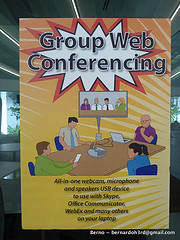
flic.kr/p/aYJBY4
Thirty years ago, business owners marveled how they ever got by without the telephone. Twenty years ago, it was the facsimile machine. Only five years ago, corporate players wondered at life before email, and today, successful business people can’t imagine life without audio and web conferencing.
This latest technological breakthrough has had a huge impact on the corporate world. Unlike typical conference calls, audio and web conferencing provides a full-featured solution for conducting on-demand meetings anywhere in the world, at any time. It is now possible and affordable for even small companies to exchange ideas and get valuable real-time input, without the inordinate expenses or hassles of travel.
The Basics
Before delving into the finer aspects of audio and web conferencing, it is important to know a few terms. “Conferencing” refers to a discussion that happens between a group of individuals, where ideas are exchanged and data are shared via a communication technology. The phrase “web conferencing” means that the whole conferencing system is conducted or hosted in a web environment, specifically a web server or application.
Audio inputs are a fundamental feature of web conferencing. Peripheral devices are placed to the computer in order to facilitate voice communication between conference participants. Devices like microphones and headphones soon gave birth to a type of communication called audio and web conferencing.
A web and audio conferencing system behaves basically like a telephone setup. It is a more economical version of phone or conference calling, but instead of establishing complicated telephone systems to confer with your staff in different office locations, you can now make use of the audio and web conferencing system. This is an economical means to keep your business moving while minimizing lost time and expensive travel and meeting room costs.
There are a number of major features in using an audio and web conferencing system.
The first and most obvious advantage is the easy-to-use audio controls. Most audio and web conferencing vendors will offer intuitive controls for audio, allowing you to easily manage your audio meeting using your telephone keypad or a form of web-based audio control panel. You are provided a wide range of options including the ability to mute lines, take roll call and lock or terminate the conference.
Not all audio and web conferencing programs utilize the existing telephone system, however, some do. With integrated, low-cost phone systems, these audio and web conferencing applications allow you to use your phone to negotiate, discuss, share, and collaborate with your clients and fellow employees.
Many audio and web conferencing tools provide easy setup, and most are intuitive with user-oriented interfaces. Some are integrated into well-known desktop items, such as Microsoft Outlook email programs.
Meetings on demand have never been much easier. For some, they’ve never been likely. Now, thanks to audio and web conferencing, with a click of the mouse you can set up a meeting right when you need it.
Tagged with: home business • web conference
Filed under: Home Business - MYO